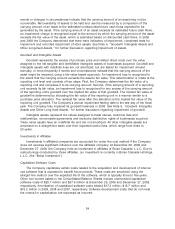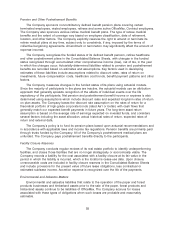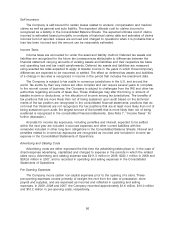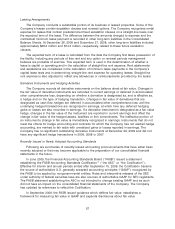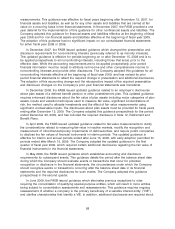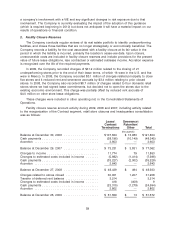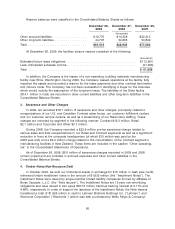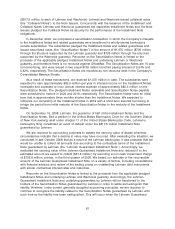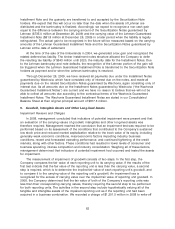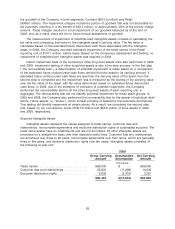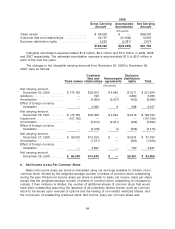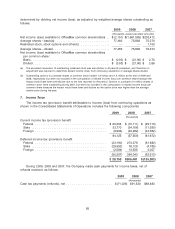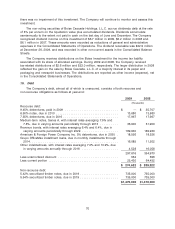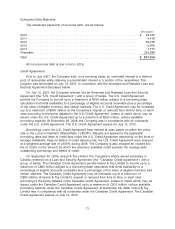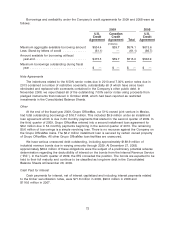OfficeMax 2009 Annual Report Download - page 66
Download and view the complete annual report
Please find page 66 of the 2009 OfficeMax annual report below. You can navigate through the pages in the report by either clicking on the pages listed below, or by using the keyword search tool below to find specific information within the annual report.Installment Note and the guaranty are transferred to and accepted by the Securitization Note
holders. We expect that this will occur no later than the date when the assets of Lehman are
distributed and the bankruptcy is finalized. Accordingly, we expect to recognize a non-cash gain
equal to the difference between the carrying amount of the Securitization Notes guaranteed by
Lehman ($735.0 million at December 26, 2009) and the carrying value of the Lehman Guaranteed
Installment Note ($81.8 million at December 26, 2009) in a later period when the liability is legally
extinguished. The actual gain to be recognized in the future will be measured based on the carrying
amounts of the Lehman Guaranteed Installment Note and the Securitization Notes guaranteed by
Lehman at the date of settlement.
At the time of the sale of the timberlands in 2004, we generated a tax gain and recognized the
related deferred tax liability. The timber installment notes structure allowed the Company to defer
the resulting tax liability of $543 million until 2020, the maturity date for the Installment Notes. Due
to the Lehman bankruptcy and note defaults, the recognition of the Lehman portion of the gain will
be triggered when the Lehman Guaranteed Installment Note is transferred to the Securitization Note
holders as payment and/or when the Lehman bankruptcy is resolved.
Through December 26, 2009, we have received all payments due under the Installment Notes
guaranteed by Wachovia, which have consisted only of interest due on the notes, and made all
payments due on the related Securitization Notes guaranteed by Wachovia, again consisting only of
interest due. As all amounts due on the Installment Notes guaranteed by Wachovia (‘‘the Wachovia
Guaranteed Installment Notes’’) are current and we have no reason to believe that we will not be
able to collect all amounts due according to the contractual terms of the Wachovia Guaranteed
Installment Notes. The Wachovia Guaranteed Installment Notes are stated in our Consolidated
Balance Sheet at their original principal amount of $817.5 million.
5. Goodwill, Intangible Assets and Other Long-lived Assets
Impairment Reviews and Charges
In 2008, management concluded that indicators of potential impairment were present and that
an evaluation of the carrying values of goodwill, intangibles and other long-lived assets was
therefore required. Management reached the conclusion that an impairment test was required to be
performed based on its assessment of the conditions that contributed to the Company’s sustained
low stock price and reduced market capitalization relative to the book value of its equity, including
generally weak economic conditions, macroeconomic factors impacting industry business
conditions, recent and forecasted operating performance, and continued tightening of the credit
markets, along with other factors. These conditions had resulted in lower levels of consumer and
business spending, intense competition and industry consolidation. Weighing all of these factors,
management determined that indicators of potential impairment had occurred and tested the assets
for impairment.
The measurement of impairment of goodwill consists of two steps. In the first step, the
Company compares the fair value of each reporting unit to its carrying value. If the results of the
first test indicate that the fair value of the reporting unit is less than the carrying value, a second
step is required, which is to determine the implied fair value of each reporting unit’s goodwill, and
to compare it to the carrying value of the reporting unit’s goodwill. An impairment loss is
recognized for the excess of carrying value over the implied fair value of reporting unit goodwill. In
2008, the Company determined that the fair value of both of the Company’s reporting units was
less than their corresponding carrying values, thereby requiring the second step to be performed
for both reporting units. The activities in the second step include hypothetically valuing all of the
tangible and intangible assets of the impaired reporting unit as if the reporting unit had been
acquired in a business combination. We recorded a charge of $1,201.5 million in 2008 to write-off
62




